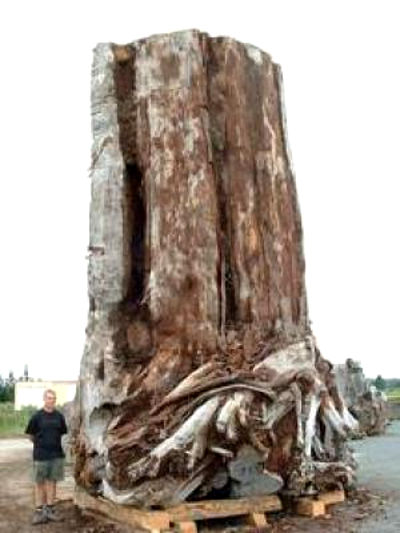
That afternoon the sun seemed to burn the top of the head. The air was hot and the sweat were streaming down on the body. However, the view in a garden in Joglo area, West Jakarta, seemed to steam all the tiredness. There, eugenia aquea fruit in container were in rows bearing fruits spoiling those who saw it.
We saw a figure of 2 m high king rose apple full of pink fruit. Some of its branches were bending down for they could not resist the weight of too much fruit. It was obvious because in one group there were 10 jumbo size of eugenia aqueas bigger than a tennis ball each. Whoever sees it would feel the desire to pick them up. ‘When they were still a valve size, I counted there were 500,’ said Yanto, the garden administer. Unfortunately, half of them were fallen because of rain.
The fruit in container of dark red eugenia aquea which has bell shape was not less interesting. The dark red fruits stood out among the green leaves, resembling a christmas bell embellishing pine tree. When they bore fruits at the same time, the group of unnamed Syzygium aqueum almost covered the whole diadem. The rose apple with slim leaves ofter bear fruits.
3 in 1
There is at least a reason if the 1,000m² garden were full of eugenia aquea fruit in container. Edy Chandra - the owner - is indeed a huge fan of that Myrtaceae family. Beside King rose which dominated the garden, Trubus also saw the Petruk's nose (Irung petruk) eugenia aquea fruit in container. The eugenia aquea from Yogyakarta has a long and oval shape resembling the nose of Petruk - one of Punakawan in Javanese Puppet story. They have shining red colour like a lipstick so that when they all appears, the fruit in container will seem to shine brightly.
Not only the red fruits, Edy Candra also collects tsunami eugenia aquea fruit in container. The fruit colour is dark green when they are young and turns to pale green when they are ripe. Eventhough the appearance is not as attractive as the red jambang family, tsunami is still a favourite because it has had a sweet and thick flesh since it is young. Moreover, the red sprinkle is enjoyable from the brownish red on the point of the leaves. The tsunami name is derived from the mother tree coming from Banda Aceh which were washed away by that massive rising wave.
In the same garden, there is also a 3 in1 fruit in container. They are actually 3 different kinds of eugenia aquea which were impregnated in 1 tree. The one which bears fruit at the same time is 3 in 1 fruit in container of apel putih, cincalo merah, and lilin hijau. ‘Eugenia aquea, including the 3 in 1, are easy to be impregnated at the same time,’ continued that father of 5. One of the main keys is actually very simple: the owner must be active in chipping young sprouts.
Appear on the stem
Such activity is done by Yanto. When eugenia aquea enter the bearing fruit time - usually at the age of 1 year after descending from the transplant - that middle age man does the leaves selection. From each stem he only leaves out 6 leaves or 3 pairs of leaves. The remainder leaves are cut off one by one by hand until their stem are released from the trunk. The purpose is to make the fruits appear from the leaves pluck point, and not on the branch point. The fruits in the branch point are dislike because of too small and few.
Within 1 week, from each leaf plucked point appear new sprouts. The prospective leaves must be chipped. It must be done over and over again - the usual frequency is once every 1 week. After 2-3 times of chipping, the prospective flowers and not the prospective leaves will appear. Beside the sprouts chipping, medium, manuring, and watering are the important factors. Yanto chose mixed medium of raw husk, burnt husk, red soil, and barn-yard manure in equal ratio.
Husk is chosen in order to keep the soil loose. The red soil is quite poor of nutrients but it does not crumple up easily and can keep water longer.
‘The lack of nutrients is overcome by manuring,’ said Yanto. Before the pot is filled with medium, raw husk is added for about 10 - 15 cm thick at the bottom in order to prevent the soil to be washed away while watering. Every 3 months, as many as 2 kg barn-yard manure from cow feces are surpressed. At the same time, the cutting off to shape the crown is done. There is no special rule, the key point is the crown shape is rounded. From the age of 1 year, an equal composition of NPK is given every 2 weeks to the plant. As much as 2 tablespoonfuls are dispersed on the medium, and watered directly to prevent it from vapouring. Using leaves manure is also applicable with the same composition.
Manuring is stopped if the prospective flowers have appeared. Manuring should be replaced by giving 1 cc Atonik per liter and 1 cc fish oil per liter over the medium. The frequency is once in a month until the fruits are ready to be picked from the trees. During the flowering process until they become fruit, the plant must not over dry. Watering should be done every day. With such treatment, the Joglo garden is ready to ‘harvest’ eugenia aquea fruit in container.









 '
'









